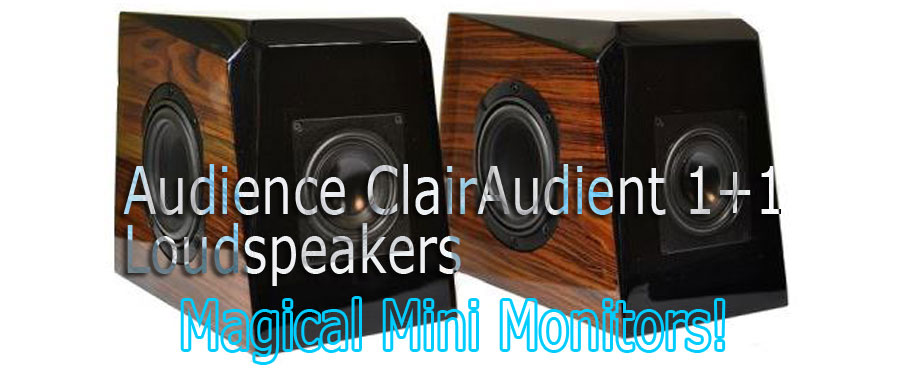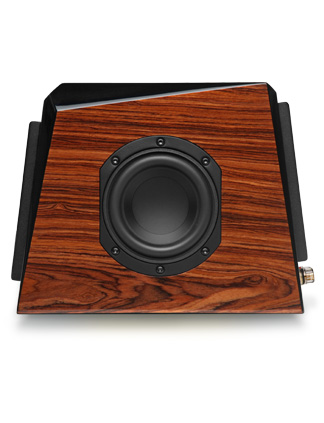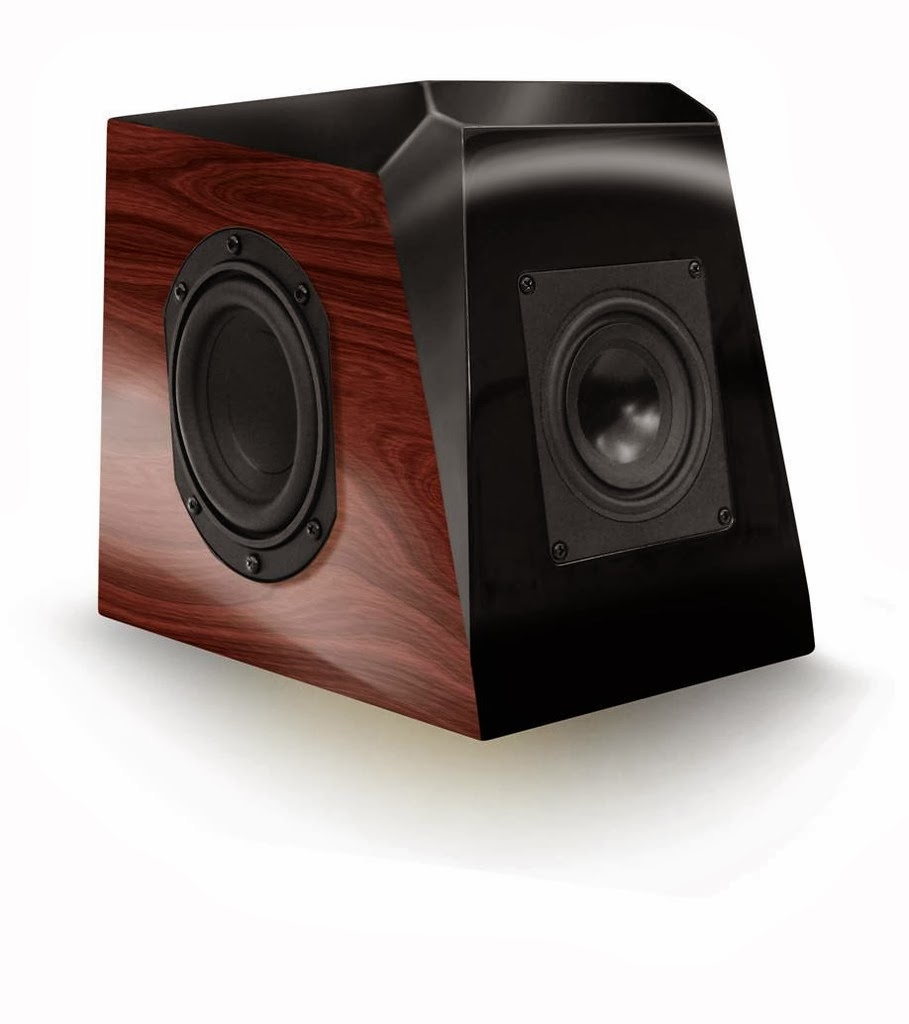Audience ClairAudient 1+1 monitors


The past six months have been a huge eye opener for me regarding innovative, small loudspeaker designs. I was bedazzled by the performance of the coax driver used in the Von Schweikert Unifield 2 Mk II monitors (see my review here).The experience had me singing the praises of monitors and I told my friends to not count out small loudspeakers—something I’d never done before. However, an asking price of $8,000 makes the Von Schweikerts too pricey for budget-minded folk.
I have since had the privilege of hearing an even smaller monitor that, at a fraction of the Von Schweikert’s cost, offers up some remarkable sonic abilities. In fact, the $1,800 Audience ClairAudient 1+1 bipolar monitor is among the very best I’ve heard—regardless of price.
Background
My first encounter with Audience was at CES back in 1997, through an invitation from Audience president John McDonald. He wanted me to hear their new, crossover-less line-source CA 16 loudspeakers (the name changed to ClairAudient 16+16 some years later). Designed by McDonald’s partner, the late Richard Smith, the CA 16’s used eight, 100 watt per channel stereo amps to power each driver independently. Audience called it a true line-source because it used a single line of full-range drivers similar to the AS-3 used today. No woofer or tweeter arrays. Although this was over fifteen years ago, I remember how impressed I was by the level of midrange naturalness and huge soundstage with no etch or high-frequency roll-off. Fast or slow, whether a blistering trumpet solo or a flute whispering in the background, there was a rightness to the music that was unmistakable (and uncommon) for a dynamic loudspeaker of its size. I did however have reservations about bass authority and impact. A little more bottom-end prowess, and I very likely would have owned a pair.
Years later saw the introduction of newer version of the 16 +16 dubbed the LSA16 (photo above), while the ClairAudient The One, the model 1+1 (here under review), the model 2+2 and two floor-standing models in the 4+4 and 8+8 were being introduced for the first time. McDonald assured me that issues with bass output had been resolved. The fix, says McDonald, was to augment the AS-3 drivers with passive mid/bass units. But I thought to myself, “there’s not enough magic in the world to make the 1+1 sound as effortless, open and dimensional as the 16+16.” But after a brief listening session, I discovered the new 1+1 did possess a fair amount of the magical midrange of the 16+16. It was astonishing to me that I could hear that unmistakable sense of rightness in such a small package and under trade show conditions. I asked McDonald for a review sample and he promised to send a pair my way.
Physical Attraction
Upon their arrival some weeks later, the first thing I noticed is how attractive they are. Standing 8″ tall, 6″ wide and 10″ deep, and weighing only 8 lbs. (!), the uniquely sloped 1+1’s are true bi-polar mini-monitors. They have a multi-angled, almost diamond shaped cabinet that houses two AS-3 drivers, front and rear. The rear driver is wired bipolar (in phase with the front driver) rather than dipolar (out of phase). The 3″ AS-3 has an unusually wide bandwidth of 50Hz to 22kHz so a crossover is not required. A pair of 3.5″ side-firing passive woofers are housed in independent, isolated chambers. The absence of crossovers has huge sonic benefits because there are no capacitors or inductors in the signal path. This approach eliminates phase anomalies as well as time and waveform distortions. At the natural low-frequency roll-off of 50 Hz, the side-firing passive radiators kick in to extend the bass response.

Before I discuss the 1+1’s sonic strengths and weaknesses, let me assure you that Audience knows a thing or two about designing audio products. They make the popular Au24 series cables, PowerChords and aR series power conditioners and have garnered numerous Most Wanted Components awards over the years. It doesn’t stop there. They also manufacture the popular Auricap XO polypropylene and Aura-TO Teflon capacitors (often employed in other designers’ loudspeakers). I can state for record that, as good as their products were since the last time I had them in-house, they’ve come a very long way since my review of the aR12 (back in 2006).

My review sample came in a standard shiny maple/black two-toned finish that blends seamlessly in this multi-driver design. There is a single 5-way binding post just below its rear firing driver. Sensitivity is 87dB, somewhat power-hungry in my opinion. I was lucky enough to find (in my garage) a pair of metal stands designed for the Morel Octave 5.2 mini-monitors I reviewed years ago. Luckily, they fit the 1+1’s like a glove.
I compared the 1+1’s with Von Schweikert’s Unifield 2 monitors, and with another loudspeaker I had in-house: the single driver, crossover-less Stein Music Master Class 1.1 which retails for about $12,000. The Von Schweikert is a 2.5 way design and requires a first-order crossover, presumably to minimize the few components in its signal path.
The LaRosita Music Server was used throughout my evaluation as a source while the G9 Audio’s 120 Nero series electronics were used for most of this evaluation in my downstairs dining room rig while the incredible sounding Audio4Soul Reference 120 stereo (PCM to PWM, digital inputs only) amplifier has me all excited of late. All cabling was the Entreq Konstantin cables and the new Audience Au24SE and PowerChord series cables.
Listening to the 1+1’s reminded me of the huge shift in my sonic expectations during my formative years. Twenty years ago, I wanted the bass to be as big and impactful as possible. Hence, my purchase of a pair of Infinity RS-1Bs. These huge four-box, planar-dynamic monoliths served as my reference for few years back in the mid ’90s. Then I had the pleasure of hearing a pair of heavily modified Magnaplanar 3.3’s. It was “love at first sound.” The novelty of hearing a box-less transducer had me reeling between excitement and disbelief. Without even knowing it, I was getting a quick education in purity and harmonic Integrity. I was entranced by the lack of coloration I heard in the 3.3’s versus the RS-1B’s (not to mention the latter’s nasty sounding electronic crossover). The utter simplicity of the 3.3’s had marveling at their overall tonal beauty and three-dimensional sound-field.
 Amazingly, McDonald and his design team have removed the boxy sound from the 1+1’s. They sound as true to the source as anything I can think of and far beyond what I expected at the price. The excellently recorded XRCD reissue of the Duke Jordan Trio’s So Nice Duke (a gift from Hideo Kiuchi, of Reimyo Audio) demonstrates how true to the source the 1+1’sare. If you enjoy jazz as much as I do, particularly small ensembles, then do yourself a favor and give this 1982 live performance a listen. In terms of sheer musicianship and recording quality, it is exhilarating and profoundly rewarding. Composed of jazz standards like All The Things You Are, Stardust, Tea For Two and my favorite, My Funny Valentine, listening to Duke’s piano solos through the 1+1’s for the first time gave me goose bumps. This timeless session deserves high praise for its excellence (see the review by Russell Lichter here). I know this CD, yet, once I heard it through the 1+1s I was stunned at how focused and precise Duke’s play appeared. This, without any over-emphasis (or de-emphasis) on the frequency extremes. The 1+1s gets the timing and harmonics just right in my opinion. This stunning performance, from a loudspeaker that can almost fit in the palm of my hand! Incredible.
Amazingly, McDonald and his design team have removed the boxy sound from the 1+1’s. They sound as true to the source as anything I can think of and far beyond what I expected at the price. The excellently recorded XRCD reissue of the Duke Jordan Trio’s So Nice Duke (a gift from Hideo Kiuchi, of Reimyo Audio) demonstrates how true to the source the 1+1’sare. If you enjoy jazz as much as I do, particularly small ensembles, then do yourself a favor and give this 1982 live performance a listen. In terms of sheer musicianship and recording quality, it is exhilarating and profoundly rewarding. Composed of jazz standards like All The Things You Are, Stardust, Tea For Two and my favorite, My Funny Valentine, listening to Duke’s piano solos through the 1+1’s for the first time gave me goose bumps. This timeless session deserves high praise for its excellence (see the review by Russell Lichter here). I know this CD, yet, once I heard it through the 1+1s I was stunned at how focused and precise Duke’s play appeared. This, without any over-emphasis (or de-emphasis) on the frequency extremes. The 1+1s gets the timing and harmonics just right in my opinion. This stunning performance, from a loudspeaker that can almost fit in the palm of my hand! Incredible.
There is a sense with the 1+1’s that tones, transients and harmonics are lingering in the air longer than usual. These qualities and the 1+1’s inherent purity are what I admire most about crossover-less designs, but I never thought they could be realized in a product this small. The similarly built Stein 1.1s are floor-standers that, for example, will exhibit weightier hammer strikes on the piano or deeper bass notes from an upright bass or bass drum. But they’re six times the asking price of the 1+1s. You can get more indeed, but you’ll pay lots more too.
 Another great recording is Friends by guitarist Stanley Jordan (no relation to Duke). Just some of the “friends” featured here: Regina Carter, Nicholas Payton, Christian McBride, Ronnie Laws, Kenny Garrett and Russell Malone. Of the eleven songs on this disc, Bathed in Light is my current favorite. I figured this multi-layered track would be a great stress test for the 1+1’s. These miniature marvels played through this track at modest volume levels with a great sense of truthfulness, musicality and openness. I felt a wonderful connection with each soloist. The sound of the 1+1’s is smaller and lighter than the Von Schweikert Unifield 2s. It’s also lighter in terms of its ability to fill the room. Yet, somehow this lack of weight and dynamic prowess never bothered me because the 1+1’s real strength, their ability to render instruments gracefully and honestly, is so convincingly well done.
Another great recording is Friends by guitarist Stanley Jordan (no relation to Duke). Just some of the “friends” featured here: Regina Carter, Nicholas Payton, Christian McBride, Ronnie Laws, Kenny Garrett and Russell Malone. Of the eleven songs on this disc, Bathed in Light is my current favorite. I figured this multi-layered track would be a great stress test for the 1+1’s. These miniature marvels played through this track at modest volume levels with a great sense of truthfulness, musicality and openness. I felt a wonderful connection with each soloist. The sound of the 1+1’s is smaller and lighter than the Von Schweikert Unifield 2s. It’s also lighter in terms of its ability to fill the room. Yet, somehow this lack of weight and dynamic prowess never bothered me because the 1+1’s real strength, their ability to render instruments gracefully and honestly, is so convincingly well done.
Switching from the G9 Audio’s Nero to the Audio4Soul model 120 digital amplifier, using an RCA SP/DIF connection, offered even greater resolution and see-through transparency without any digital artifacts. This digital dynamo does not lack body and harmonic rightness, not at all. In fact, I preferred its tighter and faster bass over the slightly more rounded and richer G9 Nero. But the G9 certainly wins when it comes to liquidity and placing instruments in a convincing holographic space. I think that, in general, well-made tube designs have this advantage over solid state amplification. That being said, I enjoyed the top-to-bottom clarity, speed and added resolution the Audio4Soul had on tap. I simply love this amplifier when playing through the 1+1s.
Conclusion
The one thing I’ve learned in my experience with the RS-1B’s, Maggies, Von Schweikerts and all the other gear that has come through my listening spaces in the past twenty years, is to accept their strengths as well as their weaknesses. Recognizing what I enjoy the most has allowed me to follow a certain path, knowing full well that everything comes at a price, and that there are always trade offs. I’ve come to hold in high esteem certain brands, such as Audio Consulting of Switzerland and Audio Note. I make no apologies for this assertion. If you had heard their components in the spaces I have, you’d agree with me. Their main strength has always been the ability to remain true to the source. You say you want lots of power and authority out of a loudspeaker? Seek elsewhere.
The Audience ClairAudient 1+1 mini-monitor has the sonic signatures and virtues I so much admire in Audio Consulting of Switzerland and Audio Note. It’s designed to play music – not frequency extremes. It’s retail cost of $1800 makes it an absolute bargain. If you’re passionate for pure tonality and harmonic integrity, and you eschew volcanic bass, then this is truly a product that deserves your attention. It certainly got mine. Highly recommended.


clement perry
Stereo Times Masthead
Publisher/Founder
Clement Perry
Editor
Dave Thomas
Senior Editors
Frank Alles, Mike Girardi, Russell Lichter, Terry London, Moreno Mitchell, Paul Szabady, Bill Wells, Mike Wright, and Stephen Yan,
Current Contributors
David Abramson, Tim Barrall, Dave Allison, Ron Cook, Lewis Dardick, John Hoffman, Dan Secula, Don Shaulis, Greg Simmons, Eric Teh, Greg Voth, Richard Willie, Ed Van Winkle, Rob Dockery, Richard Doron, and Daveed Turek
Site Management Clement Perry
Ad Designer: Martin Perry





Be the first to comment on: Audience ClairAudient 1+1 monitors